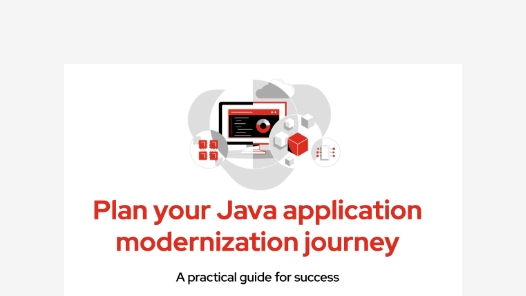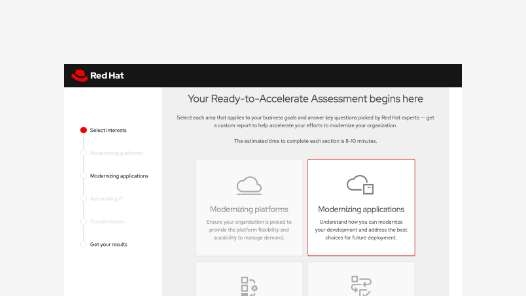Modernizing existing applications
Overview
Application modernization is a process that improves software delivery performance for a business by updating—rather than replacing—older legacy software systems.
For many organizations, this involves replatforming existing legacy workloads onto a modern cloud platform based on Kubernetes, and breaking monolithic applications into smaller pieces like microservices. It’s also common to adopt new ways of working, like DevOps, site reliability engineering (SRE) and CI/CD, as part of application modernization.
Why modernize?
Development teams
The benefits for application development teams
to modernize their application include:
Reduced technical debt
Modernizing an application can help to reduce technical debt, which can accrue when development teams add functionality to an application without fully considering its long-term impact. By modernizing an application, development teams can address issues related to technical debt and improve the overall quality of the software.
Improved teamwork and productivity
Modernized applications often enable collaboration, making it easier for development teams to work together and share code, leading to increased productivity.
Increased agility and flexibility
Modernized applications are often more agile and flexible, allowing development teams to respond quickly to changing market conditions and customer needs.
Improved scalability
Modernizing an application can help to improve its scalability, making it easier for development teams to handle increased workloads and user demands.
Access to new tools and technologies
Modernizing an application can allow development teams to use new tools and technologies, such as cloud computing, containers, and microservices, which can help to improve the performance and scalability of the software.
Enhanced security
Modernized applications can have improved security features, making it less vulnerable to cyber attacks and other security threats.
Cost savings
Modernizing an application can help to reduce development and maintenance costs over the long term, as development teams can take advantage of new technologies and tools to work more efficiently.
IT operations
The benefits for I.T. operations teams
to modernize their application include:
Improved scalability
Modernizing applications can improve their scalability, making it easier for IT operations teams to handle increased workloads and user demands.
Enhanced security
Modernized applications can have improved security features, making them less vulnerable to cyber attacks and other security threats.
Reduced maintenance and support costs
Modernizing applications can help to reduce maintenance and support costs over the long term, as IT operations teams can take advantage of new technologies and tools to work more efficiently and effectively.
Increased agility and flexibility
Modernized applications are often more agile and flexible, allowing IT operations teams to respond quickly to changing market conditions and customer needs.
Better resource utilization
Modernized applications can use resources more efficiently, reducing the amount of hardware required and lowering operating costs.
Improved compliance
Modernized applications can help organizations comply with regulations and security standards, reducing the risk of fines and penalties.
Streamlined operations
Modernized applications can help to streamline operations, making it easier for IT operations teams to manage and maintain the software.
Business leaders
The benefits for business leaders
to modernize their application include:
Increased agility and speed to market
Modernized applications can help organizations respond more quickly to changing market conditions and customer needs, providing a competitive advantage.
Improved customer experience
Modernized applications can improve the customer experience by providing better functionality, usability, and reliability.
Better data management
Modernized applications can have better data management capabilities, allowing organizations to make better decisions and gain deeper insights into their business.
Enhanced security
Modernized applications can have improved security features, reducing the risk of data breaches and other security threats.
Reduced technical debt
Modernizing applications can help to reduce technical debt, freeing up resources and improving the overall health of the IT infrastructure.
Increased productivity
Modernized applications can help to increase productivity by automating tasks and providing better tools and resources for employees.
Cost savings
Modernizing applications can help to reduce maintenance and support costs over the long term, as organizations can take advantage of new technologies and tools to work more efficiently and effectively.
What’s your modernization challenge?
Application modernization can pose various challenges based on the language, platform, or existing infrastructure. Explore more below:
Java applications
Java™ has been one of the most popular programming languages for decades. But many older Java workloads are monolithic and difficult to maintain.
Cloud Foundry workloads
Cloud Foundry presents several challenges and limitations, including heavy costs to refactor and modernize legacy applications to fit its platform and a lack of support for newer technologies.
.NET applications
Before Microsoft embraced Linux as a key platform, .NET was originally closed source and for Windows only. Several choices are available when you’re ready to modernize .NET apps.
Virtualization
Many organizations have an investment in applications that run as virtual machines. OpenShift® Virtualization is a feature of Red Hat OpenShift that allows you to run and manage virtual machines (VM) and container workloads side by side.
Modernization approach
Application modernization initiatives typically follow these high level phases:






